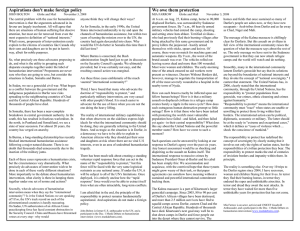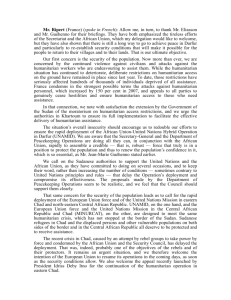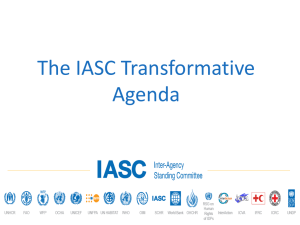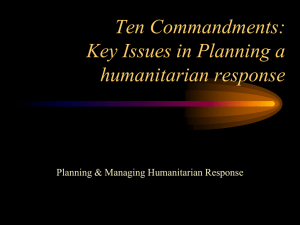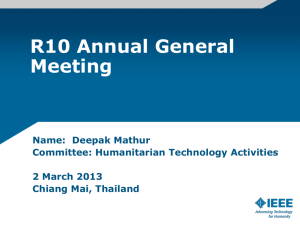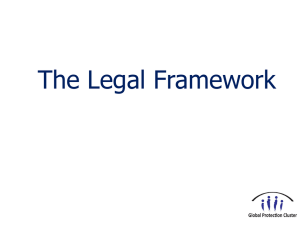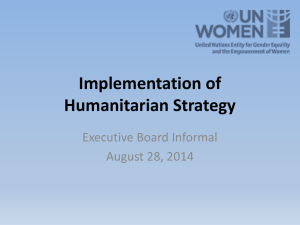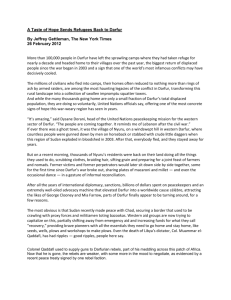Humanitarian Intervention
advertisement
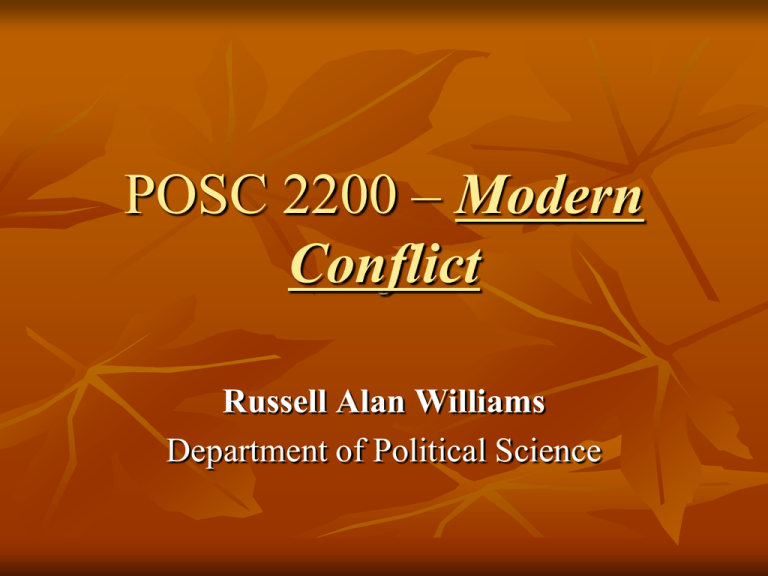
POSC 2200 – Modern Conflict Russell Alan Williams Department of Political Science Unit Five: Modern Conflict “Managing Insecurity, Human Rights and Humanitarian Intervention” Required Reading: Globalization of World Politics, 31. Badescu and Bergholm, “The Responsibility to Protect and the Conflict in Darfur: The Big Let-Down,” Security Dialogue, Vol. 40 no. 3, June 2009, Pp. 287-309. Outline: 1. 2. 3. 4. Introduction – The Context Humanitarian Intervention Challenges to Humanitarian Intervention Conclusions Term Paper Due, in class, in hardcopy March 13. The late penalty is 5% per day. 1) Introduction - The Context: Rwandan Genocide (1994): April 6 – Rwandan President Habyarimana is assassinated in the first step of a planed genocide of the Tutsi minority Next 100 days – Approximately 700,000 Rwandans are killed UN Response = Withdrawal of existing UN mission(?) Highlights the gap between UN/existing international security concepts and the reality of global politics? 1) Introduction - The Context: UN and ideals of “sovereignty” support “nonintervention” in domestic affairs . . . but most global security problems stem from domestic political problems . . . . Widespread human right problems Civil wars Endemic poverty “Failed States” =“Human Security” is threatened by “insecurities” that are not managed by existing approaches 2) Humanitarian Intervention: “Humanitarian Intervention”: States have a right (or, to some, a duty) to intervene in other states suffering large losses in human life. Resulting from either actions of that state’s government, or a systematic failure of governance. E.g. “Genocide”: Organized, or openly condoned acts, intended to destroy a national, ethnic or religious group. Illegal under UN conventions since 1948 Supported by: NGO’s & some states – E.g. Canada Radical change to both: “Sovereignty” Security 2) Humanitarian Intervention: Controversy . . . Ideas surrounding “Humanitarian Intervention” are very liberal, very optimistic and, to some, very idealistic Problems: Many states prefer existing “sovereignty” regime International law unclear on the legality of using force in other societies Concern: High risk that “Humanitarian Intervention” is a rhetoric that will be abused . . . . 2) Humanitarian Intervention: Result – Long UN process to clarify and codify legality of HI . . . . “Responsibility to Protect (R2P)” (2005): Set clearer standards for HI to try to satisfy both complaints When a state is unwilling or unable to protect its own citizens from harm, its “responsibilities” are transferred to international society. Many criteria must be met . . . . In practice – the UN plays key role in managing humanitarian intervention on a “case by case” basis. E.g. only the “Security Council” can approve “Forcible Humanitarian Intervention” 3) Challenges: Question: What is the record of the UN & international society in applying Humanitarian Intervention ideas? And do interventions reduce human suffering? A great deal of debate . . . but a few major themes: 1) Those operations that have occurred have reduced the level of human harm, at least in the short term. Text: HI is a “short term palliative” but longer term problems (e.g. like crushing poverty or ongoing ethnic conflict) may not be dealt with . . . . E.g. Somalia (?) Afghanistan (?) 3) Challenges: 2) The Problem of “selectivity”: Critics warned HI would become a problem . . . . States with national self interest in an intervention would use this a legitimating rhetoric; or that interventions would only occur when there was an ulterior motive . . . . Theoretically - Thucydides: “The strong do what they like” Selectivity and inconsistency undermine moral basis of the ideas In practice? E.g. Iraq (2003) Many US officials and scholars used emerging R2P norms to support invasion and to discredit the UN. Intervention was illegal and inconsistent with R2P rules! E.g. Darfur Badescu and Bergholm: R2P and Darfur – “the big let down” Examine the case of Darfur and the limited UN intervention – what can be learned here? Darfur? Sudanese government using militias to remove hostile population in region 250,000 dead & 2,000,000 displaced . . . . Badescu and Bergholm: R2P and Darfur – “the big let down” Examine the case of Darfur and the limited UN intervention – what can be learned here? Darfur? Sudanese government using militias to remove hostile population in region 250,000 dead & 2,000,000 displaced . . . . =Case is a “textbook example” of problems R2P was supposed to address Badescu and Bergholm: R2P and Darfur – “the big let down” Examine the case of Darfur and the limited UN intervention – what can be learned here? Their argument(s)? States did not want to pay the “costs” of intervening HI is still conceptually difficult to do “on the ground” Much of the UN’s involvement was for appearances – so that governments could say they were doing “something” Highlights the inconsistencies of R2P – But does this mean other R2P operations are illegitimate?? 3) Challenges: 3) The Problem of the UN itself (!) Without reform, Security Council members continue to have “veto power” over R2P missions . . . . The process is always “political” and inconsistent However, “Humanitarian Intervention” and its link to “human security” is not only producing new interventions, but has altered focus of arms control efforts E.g. Antipersonnel landmines E.g. Small arms (?) “Campaign to Control Small Arms” NGO Campaign E.g. “Project Ploughshares” Supporting UN “Human Security” initiatives to limit spread of “small arms” One person per minute killed Goals? A UN “Arms Trade Treaty” Limit illicit spread of weapons Regulate legal trade – where weapons likely to be used to violate human rights http://www.un.org/disarmament/convarms/ArmsTradeTreaty/html/ATT.shtml 5) For Next Time . . . Unit Five: International Security, War and Strife “Managing Insecurity, the Proliferation of Weapons of Mass Destruction (WMD’s)” Required Reading: Globalization of World Politics, Chapter 24. John Mueller. “The Essential Irrelevance of Nuclear Weapons: Stability in the Postwar World,” International Security, Vol. 13(2), (Fall 1988), Pp. 5579. (Available from e-journals, or as an excerpt, from the instructor). Term Paper Due, in class, in hardcopy, March 13. The late penalty is 5% per day.
